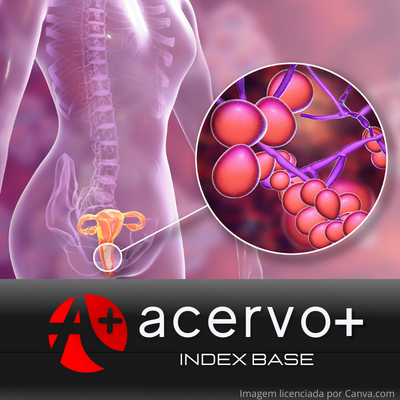Relação entre alimentação e crescimento de Candida para desenvolvimento da Candidíase Vulvovaginal Recorrente
##plugins.themes.bootstrap3.article.main##
Resumo
Objetivo: Demonstrar a relação entre a alimentação e a presença de risco e fatores associados ao crescimento de Candida, para aderência da candidíase vulvovaginal recorrente. Métodos: Foi realizado uma revisão integrativa com busca na PubMed com o objetivo de analisar os descritores para os temas abordados ao longo do estudo. Executou-se uma busca, em setembro de 2022, recorrendo à seguinte sintaxe: candidiasis AND influence AND nutrition. Foi também usado o filtro condicional dos estudos terem sido publicados de 2012 a 2022. Resultados: Foram encontrados 17 artigos relacionados ao tema, dos quais 8 artigos foram excluídos e 9 foram selecionados. As razões para a exclusão dos artigos foram por não estarem acessíveis na íntegra (X=3), por se tratar de artigos com outras temáticas em relação a candidíase (X=5) e por não apresentarem dados epidemiológicos referentes à influência da alimentação na candidíase, objeto deste estudo. Considerações finais: As terapias adjuvantes demonstram a importância da mudança de hábitos alimentares e como ajudam na prevenção da patologia ou progressão da doença, já que a microbiota intestinal afeta diretamente a saúde e o sistema imunológico do aparelho geniturinário feminino, equilibra o pH da vagina e evita o ambiente mais ácido, evitando assim a proliferação de fungos.
##plugins.themes.bootstrap3.article.details##
Copyright © | Todos os direitos reservados.
A revista detém os direitos autorais exclusivos de publicação deste artigo nos termos da lei 9610/98.
Reprodução parcial
É livre o uso de partes do texto, figuras e questionário do artigo, sendo obrigatória a citação dos autores e revista.
Reprodução total
É expressamente proibida, devendo ser autorizada pela revista.
Referências
2. DAVID LA, et al. Diet rapidly and reproducibly alters the human gut microbiome. Nature 2014; 505: 559-563.
3. DENNING DW, et al. Global burden of recurrent vulvovaginal candidiasis: a systematic review. Lancet Infect Dis. 2018;18(11): e339-e347.
4. DE SETA F, et al. Lactobacillus plantarum P17630 for preventing Candida vaginitis recurrence: a retrospective comparative study. Eur J Obstet Gynecol Reprod Biol. 2014; 182: 136-9.
5. DINICOLANTONIO JJ, et al. Added fructose: a principal driver of type 2 diabetes mellitus and its consequences. Mayo Clin Proc. 2015; 90(3): 372-81.
6. EBRAHIMY F, et al. Comparison of the therapeutic effects of Garcin(®) and fluconazole on Candida vaginitis. Singapore Medical Journal. 2015; 56(10): 567-572.
7. ENE IV, et al. Carbon source-induced reprogramming of the cell wall proteome and secretome modulates the adherence and drug resistance of the fungal pathogen Candida albicans. Proteomics. 2012; 12(21): 3164-79.
8. FERREIRA HMG. Pesquisa e desenvolvimento tecnológico no setor energético brasileiro: prioridades, concentrações e direções dos esforços de inovação. Tese (Tese em administração) - Universidade Municipal de São Caetano do Sul, São Caetano do Sul, 2017; 117 p.
9. FIRMIANO L, et al. Benefício dos Alimentos Usados como Terapia Complementar para Candidíase Vulvovaginal Recorrente. Id on Line Rev. Mult. Psic. 2020; 14(53): 913-925.
10. GIUDICE G, et al. Rhinocerebral Mucormycosis with Orosinusal Involvement: Diagnostic and Surgical Treatment Guidelines. Endocr Metab Immune Disord Drug Targets. 2016; 16(4): 264-269.
11. GUNSALUS KTW, et al. Manipulation of host diet to reduce gastrointestinal colonization by the opportunistic pathogen Candida albicans. Host Microbe Biology. 2015; 1(1): 1-16.
12. HOFFMANN C, et al. Archaea and fungi of the human gut microbiome: correlations with diet and bacterial residents. Plos One, 2013, 8(6):1-12.
13. JEZIOREK M, et al. The influence of diet on gastrointestinal Candida spp. colonization and the susceptibility of Candida spp. to antifungal drugs. Rocz Panstw Zakl Hig. 2019;70(2):195-200.
14. JOHNSON MD, et al. Cytokine gene polymorphisms and the outcome of invasive candidiasis: a prospective cohort study. Clin Infect Dis. 2012;54(4):502-10.
15. KUMAMOTO CA, et al. The gut, the bad and the harmless: Candida albicans as a commensal and opportunistic pathogen in the intestine. Current Opinion in Microbiology. 2020;56:7-15.
16. MACKIE J, et al. Host-Imposed Copper Poisoning Impacts Fungal Micronutrient Acquisition during Systemic Candida albicans Infections. PLoS One. 2016;11(6):e0158683.
17. MAN A, et al. New perspectives on the nutritional factors influencing growth rate of Candida albicans in diabetics. An in vitro study. Mem Inst Oswaldo Cruz. 2017;112(9):587-592.
18. PAPPAS PG, et al. Clinical Practice Guideline for the Management of Candidiasis: 2016 Update by the Infectious Diseases Society of America. Clin Infect Dis. 2016;62(4):e1-50.
19. PERICOLINI E, et al. Therapeutic activity of a Saccharomyces cerevisiae-based probiotic and inactivated whole yeast on vaginal candidiasis. Virulence. 2017;8(1):74-90.
20. POTRYKUS J, et al. Fungal iron availability during deep seated candidiasis is defined by a complex interplay involving systemic and local events. PLoS Pathog. 2013;9(10):e1003676.
21. PRATYUSHA VA, et al. Ras hyperactivation versus overexpression: Lessons from Ras dynamics in Candida albicans. Sci Rep. 2018;8(1):5248.
22. ROSATI D, et al. Recurrent Vulvovaginal Candidiasis: An Immunological Perspective. Microorganisms. 2020;8(2):144.
23. SELEEM D, et al. Review of flavonoids: A diverse group of natural compounds with anti-Candida albicans activity in vitro. Archives of Oral Biology. 2017;76:76-83.
24. SERRANO-FUJARTE I, et al. Influence of culture media on biofilm formation by Candida species and response of sessile cells to antifungals and oxidative stress. Biomed Res Int., 2015; 2015: 783639.
25. SOBEL JD. Recurrent vulvovaginal candidiasis. Am J Obstet Gynecol., 2016; 214(1): 15-21.
26. VAN RIEL SJJM, et al. Treating (Recurrent) Vulvovaginal Candidiasis with Medical-Grade Honey-Concepts and Practical Considerations. J Fungi (Basel). 2021;7(8):664.
27. WHALEY SG, et al. Azole Antifungal Resistance in Candida albicans and Emerging Non-albicans Candida Species. Front Microbiol. 2017;7:2173.

